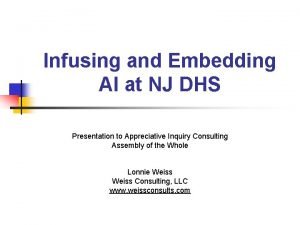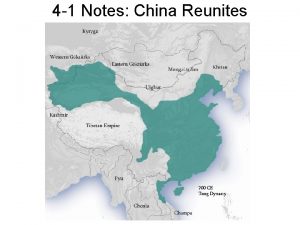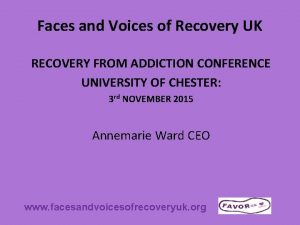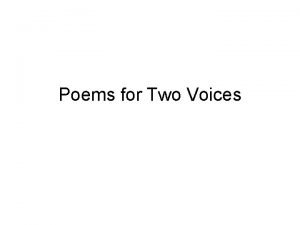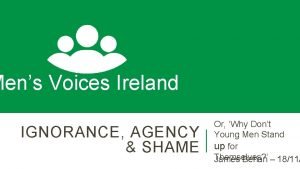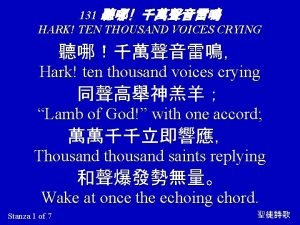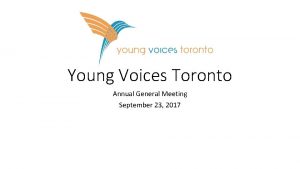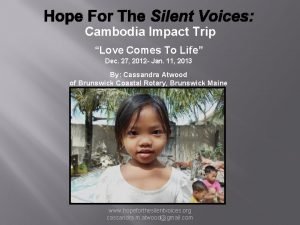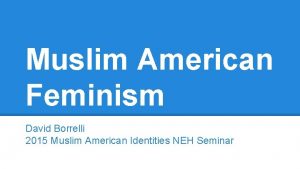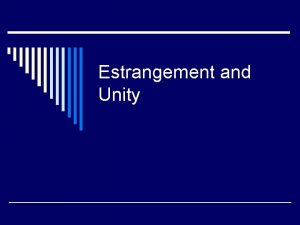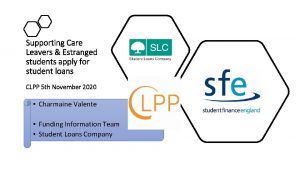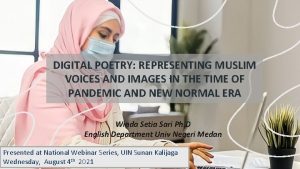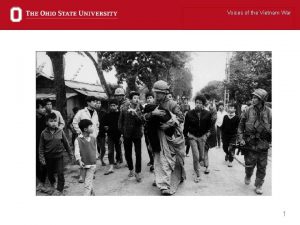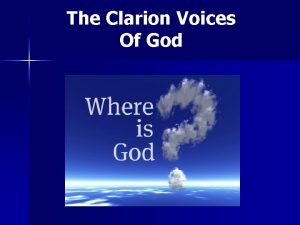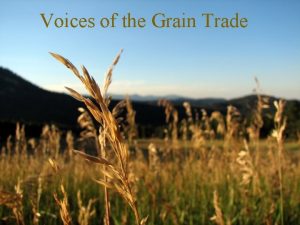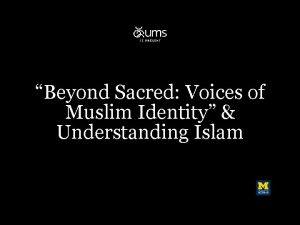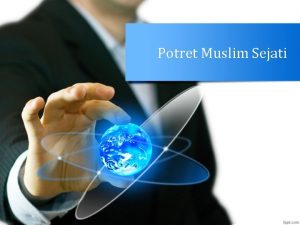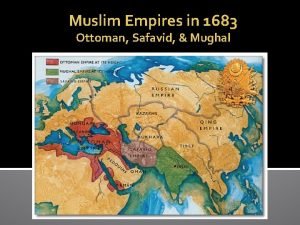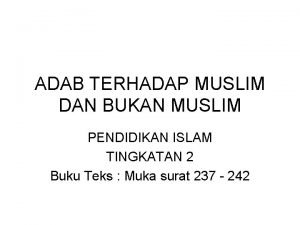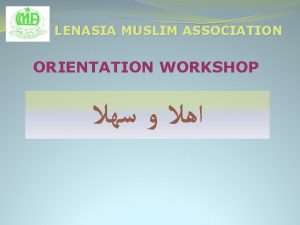Reuniting Estranged Voices Infusing Muslim American History and
















- Slides: 16

Reuniting Estranged Voices: Infusing Muslim American History and Life into the classroom Content wayfinding within Ohio Department of Education American History curriculum constructs in coursework at Fostoria City Schools By: Brian Shaver

Methodology ● Given: the Question: “How will you integrate information about Muslim Americans into your classroom? ” ● Given: the Ohio Department of Education (ODE) content standards and high stakes testing framework coupled with the Ohio Teacher Evaluation Standards (OTES) with a Valued Added component required specific conscientious attention to these variables to teach every lesson. ● Utilizing each of the relevant content standards within the ODE construct to relate to material and topics that can be integrated within each content strand ● This will be basic with an extrapolation in a few areas of PBL. ● Allow this document to be utilized as a resource for this cohort, my cohort of AH teachers in Fostoria Schools and other teachers within Ohio

ODE Content Standards https: //education. ohio. gov/getattachment/Topics/Ohio-s-New-Learning. Standards/Social-Studies/SS-Standards. pdf. aspx (Inshallah you have a visual of this specifically) American History (pages 29 -31) (1877 to present) 9 Topics 33 Content Statements The next slides are by no means exhaustive to what can be done

Topic: Historical Thinking and Skills 1. Historical events provide opportunities to examine alternative courses of action 2. The Use of primary and secondary sources. . . 3. Historians develop theses and use evidence to support and refute positions 4. Historians analyze cause and effect, sequence and correlation in historical events, including multiple causation and long and short- term causal relationships These are overarching concepts that appear daily within the framework of the course and the other content areas Using both versions of opening scenes of Roots to illustrate the necessity of studying history (specifically Muslims in America)

Topic 2: Historic Documents These too will be treated as overarching concepts within the framework of this course as it is supposed to begin in 1877 5. The Declaration of Independence. . . 6. The NW Ordinance of 1787. . . 7. Articles of Confederation and US Constitution 8. Federalist v Anti-Federalist. . . 9. Bill of Rights. . . Much overlap in rhetoric and speech with language in Declaration of Independence and Constitution that is infused with NOI materials from Elijah Muhammad, Malcolm X, Farrakhan (and other nationalist movements)

Topic 3: Industrialization and Progressivism 10. Transformation of Am. economy from agrarian to urban industrialized The concept of modernity can be explored 11. Expanding workforce - the rise of labor movements 12. Immigration, internal migration and movement (Push-pull factors, white v. non -white, Arab Detroit and Ford Motor) 13. Institutionalizing racial discrimination 14. Effort to address the ills of Am. Society Noble Drew Ali, Garveyism, and social clubs (Shriners) etc.

Topic 4: Foreign Affairs from Imperialism to Post WWI 15. Overseas expansion (Imperialism) and WWI (Ottoman Empire and the Treaty of Versailles- effects on immigration and politics) 16. Result of WWI and US return to isolationism. . . (immigration policy changes Am. Heritage Act 1924. . . )

Topic 5: Prosperity, Depression and the New Deal 17. Racial intolerance, anti-immigrant attitudes. . social unrest 18. Improved Standard of Living, innovations. . . social and cultural changes and tensions 19. Harlem Renaissance, African American migration. . . social change 20. Great depression. . . expanding federal government. . . (WPA interviews, expanding labor union movement, George F. Addes, etc. )

Topic 6: From Isolation to World War 21. . isolationism. . . WWII 22. . mobilization. . . changes in Am. Society

Topic 7: The Cold War 23. Use of atomic weapons. . . nuclear age 24. . containment. . . 25. . . Mc. Carthyism. . . review Korematsu v. US, add the Crucible (parody of Mc. Carthyism by Arthur Miller) add US v. Ujaama and Safi “Being Muslim, being American after 9/11” -- have a culminating discussion and relate the institutional nature of targeting groups – discussion include “Black Lives Matter” 26. . Korea/Vietnam. . . (continue to fill the gap with Afghanistan and Iran in context of immigration and community transformation) 27. . . collapse of communist governments in Eastern Europe and USSR. . . Where does the focus of fear turn?

Topic 8: Social Transformations in the US 28. Following WWII. . Racial and gender equity and extension of civil rights much is done in my class to discuss this and has been covered by other presenters 29. the post war economic boom. . . 30. the continuing population flow from cities to suburbs, internal migrations. . . Increase of immigration resulting from the passage of the 1965 immigration act have led to social and political effects. 31. Political debates focused on the extent of the role of government. .


Topic 9: US and Post Cold War World 32. Improved global communication, international trade. . 33. The United States faced new political, national security and economic challenges in the post-Cold War world and following the attacks on September 11, 2001.

American History Song Project Teaching with the Senses Queen Latifa – “Just Another Day” https: //www. youtube. com/watch? v=zl. EVYJPqi. VQ (1: 57 - 2: 22) Ice Cube “Steady Mobbin” https: //www. youtube. com/watch? v=t. Mx. Xt. OU 09 t. M (first minute) Discussion – Points of Interests ?

Song Project Continued ● What about the Bean Pie? Have you ever had bean pie? ● https: //slate. com/news-and-politics/2018/07/bean-pie-history-shows-why-itsthe-only-real-muslim-american-food. html ● Variations accepted and appreciated (spoken word piece, karaoke, group of songs, genre of music, etc. ) the goal is a historical analysis ● Examples of Songs with American Muslim Historical content/conversation ○ “Hi Jolly” New Christy Minstrels (1963) ○ “Culture of Terrorism” Capital D and other Capital D songs ○ “Uncle Sam, Goddamn” Brother Ali (2007) and many other Brother Ali songs ○ “Words I never said” Lupe Fiasco (as an artist) https: //www. youtube. com/watch? v=22 l 1 sf 5 JZD 0

Questions? Comments?
 Destiny 2 infusing
Destiny 2 infusing 618 ad
618 ad Reuniting china
Reuniting china Magical realism meaning
Magical realism meaning Abb zaragoza
Abb zaragoza Chapter 9 voices and instrument families
Chapter 9 voices and instrument families Faces and voices of recovery uk
Faces and voices of recovery uk Passive voice verb
Passive voice verb A graduation poem for two
A graduation poem for two Men's voices ireland
Men's voices ireland Dust bowl pictures woman
Dust bowl pictures woman Hark ten thousand voices crying
Hark ten thousand voices crying 5 voices assessment
5 voices assessment Hark ten thousand voices crying
Hark ten thousand voices crying Hark ten thousand voices crying
Hark ten thousand voices crying Young voices toronto
Young voices toronto Hope for the silent voices
Hope for the silent voices
